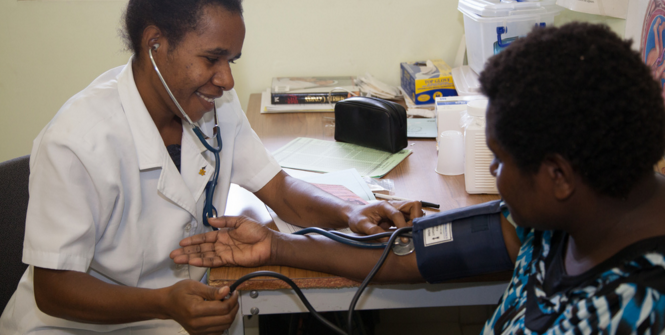Securing Indo-Pacific Health Security: Australia’s Approach to Regional Health Security

In the wake of several prominent disease outbreaks, the Australian government has committed itself to strengthening regional health security.
From “regional preparedness” to “regional health security”
The Australian Government maintains a strong interest in the health affairs of Indo-Pacific countries. With a combined population comprising two-thirds of the entire world, extensive urbanisation, intensive animal farming practices, huge variation in health system capacity within and between countries, a history of public health events that have included novel pathogens, and the progressive spread of antimicrobial resistance, the Indo-Pacific region has understandably attracted the reputation as serving as both an “epicentre” and “hotbed” of infectious diseases. In this context, Australia’s extensive international travel and trade arrangements with the region may be viewed by some as hazardous, potentially jeopardising the health, wellbeing and security of Australia’s population; but it can equally be viewed as offering a valuable opportunity for Australia to assist its neighbours in extending technical assistance, thereby increasing Australia’s ability to exert soft power and influence throughout the region.
In 2017 the Australian Government again made international headlines following Julie Bishop’s announcement of a new AU $300 million commitment to strengthening regional health security. The Australian foreign minister’s proclamation followed the appointment of a new Ambassador for Regional Health Security, Mr Blair Exell. Australia also accepted to serve as co-chair of the Joint External Evaluation (JEE) Alliance that was committed to assisting countries meet their obligations under the International Health Regulations (2005) by strengthening core capacities to detect, prevent, and control public health emergencies of international concern.
These various announcements took many within the Australian public health and development communities by surprise, principally due to the previous reductions in Australia’s foreign aid budget instituted by Prime Minister Tony Abbott and maintained by the Turnbull Government. Indeed, for many, these various announcements appeared to emerge without prior warning that Australia’s conservative political leadership held any interest in health-related aid work. Arguably, several factors contributed to the Australian Government’s renewed interest in regional health matters.
The fact that Australia had assumed a prominent financial role in supporting APSED I and II, and there were a number of discussions throughout 2015 and 2016 about the need for APSED III, fed into internal policy discussions within the Australian Department of Foreign Affairs and Trade (DFAT). development communities had become increasingly concerned though about the rising influence of new development partners in the Pacific displacing Australia’s influence, specifically the People’s Republic of China, being seen to help address the spread of Zika in the Pacific aligned with Australia’s doctrine of “strategic denial” of excluding rival powers to retain prominence throughout the region. Being publicly observed to take strong action on the spread of Zika and other regional health “threats” would also likely sit well with the Australian public, in view of the fact anxiety was growing about the virus’ potential spread to Australia. As a result, even before the October 2017 regional health security announcement Julie Bishop had announced an AU $7.7 million funding package targeting mosquito-borne diseases in Vanuatu, Fiji and Kiribati which included research on preventing the transmission of Zika.
The “problem” with adopting a regional focus
As the 2009 H1N1 influenza pandemic, the 2014 West African Ebola outbreak and pathogens such as the Middle East Respiratory Syndrome (MERS) coronavirus have amply demonstrated, infectious diseases can potentially arise from anywhere to rapidly spread internationally. The first case of the 2009 H1N1 virus to be detected in Australia, for example, was recorded on 9 May 2009, almost four weeks after the first cases were officially reported in the United States. By comparison, H1N1 was detected in Hong Kong within a week of the virus being identified in Mexico. Although much slower, MERS, which was first identified in 2012 in the Middle East, had spread to over 25 countries throughout Europe, Asia, North America and the Middle East, in six years and resulted in over 1,300 cases. While no cases of Ebola were imported into Australia during the 2014 outbreak in West Africa, the detection of individuals infected with the virus in the United States, Spain, Italy and the United Kingdom did cause sufficient alarm as to prompt the creation of a dedicated United Nations mission along with multiple bilateral and multilateral offers of support to contain the disease. Put simply, diseases can and do arise from multiple locations and, where the capabilities and means permit, they can be transported to any other terrestrial location within 24–48 hours.
To what extent, therefore, is a government’s exclusively regional focus on infectious diseases appropriate in a highly-interconnected, globalised world? The succinct answer is “probably not”; although equally, the Indo-Pacific region may provide a more sound rationale for such investment compared to other regions. As noted earlier, the Indo-Pacific region currently comprises two-thirds of the world’s entire (human) population. The fact that two of the world’s most populous nations – China and India – each with a population well in excess of 1 billion people are co-located within the same geographic area, provides sufficient cause to warrant international attention to the health affairs of the region. In this context, although it has often been observed in respect to economic considerations that “When China sneezes, Asia catches a cold”, the same is indubitably accurate with respect to the microbial world as several disease events discussed below attest. Likewise, while antimicrobial resistance in South East Asia has been identified to be a major public health problem, India’s infectious disease burden is amongst the highest in the world, and poor sanitation, malnutrition, and inadequate regulation of the pharmaceutical sector is contributing to the rise of AMR.
Given these multiple factors, it could perhaps be expected that the Australian Government would display a keen (self) interest in the health challenges emanating from the Indo-Pacific region. It is also the case that a regional focus aligns with Australia’s traditional approach to foreign policy, one which adopts a concentric circle approach – those countries closest to Australia receive the greatest attention, funding and priority, while those more distant receive less. For Australia, therefore, countries such as Papua New Guinea, Indonesia, the Solomon Islands, and Timor-Leste receive the lion’s share of Australian official development assistance (ODA), and health (linked with education) remains one of the government’s top six investment priorities. Within this broader context, addressing the health risks with cross-border potential emanating from the region remains key, both with respect to protecting the health and wellbeing of Australia’s population as well as strengthening the health systems of neighbouring countries.
Historically, governments of all political persuasions have tended to adopt a foreign policy focus on countries within their immediate region. It is also the case that self-interest has also been a common feature of foreign policy decisions, especially with regards to the allocation of ODA. For these reasons it would be disingenuous for the Australian Government to be criticised for adopting a policy that has as part of its objective to help protect the Australian population. Moreover, given the disease burden that currently exists throughout the region, the variation in health system capacities, and the consequent human suffering, it should matter little whether enlightened self-interest or altruism is the primary motivation of the Australian Government’s new regional health security initiative. Conceivably, the more important consideration is whether the assistance offered is the assistance sought, and that it is offered in a manner consistent with the aims and priorities of the recipient countries.
Associate Professor Adam Kamradt-Scott specialises in global health security and international relations. His research and teaching explores how governments and multilateral organisations cooperate and interact when adverse health events such as disease outbreaks, epidemics and pandemics occur, as well as how they respond to emerging health and security challenges.
This article is an extract from Kamradt-Scott’s article in Volume 72, Issue 6 of the Australian Journal of International Affairs titled “Securing Indo-Pacific health security: Australia’s approach to regional health security.” It is republished with permission.





